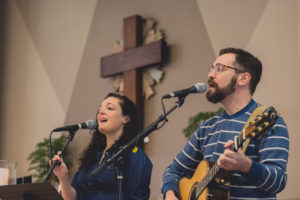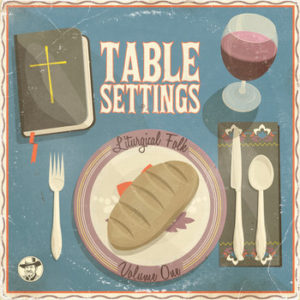Guest Blogger Ryan Flanigan is a liturgical folks artist and church music director at All Saints Church Dallas where this story of intergernational worship occurs. As an artist rooted in the Christian Story, Ryan works to create beautiful and believable sacred music for the sake of the world. He believes the church can be a credible witness of God’s beauty, truth and goodness to the whole world, not just Christians. Ryan lives in Dallas TX with his wife Melissa and their three kids Lily, Liam, and Noelle. He is the founder of Liturgical Folk and a core team member of United Adoration.
“I appeal to you therefore, brothers, by the mercies of God, to present your bodies as a living sacrifice, holy and acceptable to God, which is your spiritual worship. Do not be conformed to this world, but be transformed by the renewal of your mind, that by testing you may discern what is the will of God, what is good and acceptable and perfect.” – Romans 12:1-2 (ESV)
The Coffee Shop
 One Friday in late July my wife Melissa and I, along with our three young kids, got in the minivan and, as we do every Friday summer morning, headed to the coffee shop. The coffee shop is the epicenter of our neighborhood life. Without compromising the aesthetic of craft coffee culture, the owner, who also has young kids, built his coffee shop with the whole neighborhood in mind, not only hipster Millennials. He did not necessarily design it to be family-friendly; he just built a very good and pleasant place to gather. Sure enough, people of all ages flock there. For a couple hours that Friday morning we engaged naturally in conversation after conversation with neighbors coming and going, babies being passed around, and kids circling us playfully. It is always a truly unmanufactured intergenerational experience.
One Friday in late July my wife Melissa and I, along with our three young kids, got in the minivan and, as we do every Friday summer morning, headed to the coffee shop. The coffee shop is the epicenter of our neighborhood life. Without compromising the aesthetic of craft coffee culture, the owner, who also has young kids, built his coffee shop with the whole neighborhood in mind, not only hipster Millennials. He did not necessarily design it to be family-friendly; he just built a very good and pleasant place to gather. Sure enough, people of all ages flock there. For a couple hours that Friday morning we engaged naturally in conversation after conversation with neighbors coming and going, babies being passed around, and kids circling us playfully. It is always a truly unmanufactured intergenerational experience.
From the coffee shop we headed to lunch at the home of an older couple, spiritual parents to Melissa and me and honorary grandparents to our kids. We shared in a delightful spread of fruit salad, chicken salad, quinoa salad, potato salad, every kind of salad except salad, and homemade cinnamon rolls. The kids ran around in the beautiful backyard garden and, when it got too hot, came inside for crafts with the moms, while the men exchanged philosophical thoughts. Then we sat and listened to endearing stories, some of them for the second or third time, of the last half century of our mentors’ life together. Another unforced intergenerational experience.
Worship Wars
The worship wars have been wreaking havoc on the modern church for decades. As a result intergenerational relationships have suffered. Attempts at accommodating differing worship preferences have only widened this relational gap. It is not uncommon for a church to offer separate worship services for kids, students, contemporary worshipers, and traditional worshipers, each with its own music style and spatial aesthetic. Even midweek groups are often segregated into common interests or life stages. Although these strategies appear to be helping churches by increasing Sunday attendance, they may actually be stunting the spiritual growth of churchgoers.
Every generation plays an important role in human formation and flourishing. Before we receive an individual identity, we inherit a familial identity. – Ryan Flanigan
The accommodation of preferences is rooted in the cultural values of consumerism and individualism. Of course the generations are divided; we all prefer different things. And despite the good intentions of leaders to attract worshipers by making them feel comfortable and undistracted, catering to their culturally-formed personal preferences is at cross-purposes with the gospel. The gospel calls us to lay down our own preferences and to prefer others instead (Mark 8-10). Christian worship is all about deference, not preference, modeled for us in our sacrificial Savior Jesus Christ himself (Philip. 2). Worship at its best is a rehearsal of the sacrificial life, and yet in many cases it has become another provider of goods and services. Nothing has contributed to generational division more than this.
Life and Liturgy
As I narrated in the story above, our everyday lives are intergenerational. Every generation plays an important role in human formation and flourishing. Before we receive an individual identity, we inherit a familial identity. Extended families are made up of three or four, sometimes five, living generations supporting one another and carrying on family traditions and stories. As Christians, we are extended families on mission with God. We need the active presence of all generations in order to be the family God has called us to be, to embody the Faith, and to carry on our Story in the world. Christian worship is the gathering, equipping, feeding, and sending of families to do life together on mission with God.
 I am part of a liturgical church. Liturgy simply means “service of the people.” Paul uses it in Romans 12 to describe the spiritual “service” of offering our bodies as living sacrifices to God. Liturgical practices offer tangible means by which the generations are united in worship. One of my favorite moments of our liturgy is when my children run up to the communion rail to join me in receiving the body and blood of Christ. One Sunday my son knelt down, extended his hands to receive, and said, “Look dad, I’m making a manger.” The old woman to my left started chuckling, and I was inspired by the incarnation illustration my son had just unknowingly given us.
I am part of a liturgical church. Liturgy simply means “service of the people.” Paul uses it in Romans 12 to describe the spiritual “service” of offering our bodies as living sacrifices to God. Liturgical practices offer tangible means by which the generations are united in worship. One of my favorite moments of our liturgy is when my children run up to the communion rail to join me in receiving the body and blood of Christ. One Sunday my son knelt down, extended his hands to receive, and said, “Look dad, I’m making a manger.” The old woman to my left started chuckling, and I was inspired by the incarnation illustration my son had just unknowingly given us.
The liturgy brings out the physical nature of our worship, without which our worship can become a strictly cognitive or abstract exercise. Physical symbols and actions ensure that our bodies are engaged. Kneeling, praying, and singing in unison draws us into communion with one another and with God. This is especially important for children. Jesus was clear with his disciples to let the children come to him (Mark 10). When the children are left out, kingdom values go away. When kingdom values go away, cultural values take over. We begin to conform our worship to the things of the world, which is the antithesis of spiritual liturgy (Rom. 12). So Paul urges us, children included, to offer our bodies together in sacrificial life and liturgy.
Music Unites
Music is vital to Christian worship. It’s no wonder, then, that music is near the heart of the worship wars. The generations divide along fault lines of stylistic preference. When music is commodified to serve the people, it becomes entertainment. Music is supposed to be a service of the people, not a service to the people. This paradigm shift will help us defer our own musical tastes in worship and to consider what makes others sing. It will take a willingness for mutual appreciation, but in time our hearts will blend into one. A church may even discover its own unique musical expression!
 Life is a bell curve of simplicity and complexity. The most unifying songs and rhythms noticeably engage the youngest and oldest among us. If we aim for the people in the middle, those whose lives are most cluttered and noisy, they may connect with the music, but it will be hard for everyone else to participate. Familiarity is the way to go with liturgical music. Familiar doesn’t mean that we need to dumb it down; it means we’re bringing it down to earth, making the music more accessible and the work of the people more doable.
Life is a bell curve of simplicity and complexity. The most unifying songs and rhythms noticeably engage the youngest and oldest among us. If we aim for the people in the middle, those whose lives are most cluttered and noisy, they may connect with the music, but it will be hard for everyone else to participate. Familiarity is the way to go with liturgical music. Familiar doesn’t mean that we need to dumb it down; it means we’re bringing it down to earth, making the music more accessible and the work of the people more doable.
What this looks like at All Saints Dallas is children, parents, empty nesters, singles, and students all singing alongside one another. We usually sing thirteen songs per service, including ancient hymns, contemporary choruses, folk spirituals, and new service music. Each song supports the liturgy in some way. Key signatures and melodic ranges are intentionally chosen to enable ease of congregational singing. Rhythms and arrangements are contextualized to what best engages our people, especially the old and young. And we have indeed discovered our own unique sound as a church.
Liturgical Folk
 Our music, which we call Liturgical Folk, is a truly intergenerational project. You can read all about it in the Dallas Morning News article, “Let us bow our heads in poetry,” and you can hear what it sounds like on our albums, Liturgical Folk, Vols. 1 & 2. Volume 1 is called Table settings, and consists of singable settings of historic prayers for churches and families. My wife and kids sing on it. Volume 2 is called Edenland and consists of new hymns written by a seventy-five year old in our church and myself. He wrote the words, and I wrote the tunes.
Our music, which we call Liturgical Folk, is a truly intergenerational project. You can read all about it in the Dallas Morning News article, “Let us bow our heads in poetry,” and you can hear what it sounds like on our albums, Liturgical Folk, Vols. 1 & 2. Volume 1 is called Table settings, and consists of singable settings of historic prayers for churches and families. My wife and kids sing on it. Volume 2 is called Edenland and consists of new hymns written by a seventy-five year old in our church and myself. He wrote the words, and I wrote the tunes.
Conclusion
Robert Webber said that the greatest internal threat to Christian worship is cultural accommodation. When churches become providers of goods and services, generations divide and intergenerational relationships suffer. There is much more we could talk about, such as the dwindling percentage of churchgoing college students who grew up in age-segregated churches. I have chosen to highlight from my own experiences how liturgy and music can help bridge the generational divides. There really shouldn’t be a disconnect between our church life and our everyday life. What we do in worship should train us in our everyday lives, helping us carry on the Story of God in flourishing intergenerational relationships.
Read our other blogs!

Guest Blogger Ryan Flanigan


 One Friday in late July my wife Melissa and I, along with our three young kids, got in the minivan and, as we do every Friday summer morning, headed to the coffee shop. The coffee shop is the epicenter of our neighborhood life. Without compromising the aesthetic of craft coffee culture, the owner, who also has young kids, built his coffee shop with the whole neighborhood in mind, not only hipster Millennials. He did not necessarily design it to be family-friendly; he just built a very good and pleasant place to gather. Sure enough, people of all ages flock there. For a couple hours that Friday morning we engaged naturally in conversation after conversation with neighbors coming and going, babies being passed around, and kids circling us playfully. It is always a truly unmanufactured intergenerational experience.
One Friday in late July my wife Melissa and I, along with our three young kids, got in the minivan and, as we do every Friday summer morning, headed to the coffee shop. The coffee shop is the epicenter of our neighborhood life. Without compromising the aesthetic of craft coffee culture, the owner, who also has young kids, built his coffee shop with the whole neighborhood in mind, not only hipster Millennials. He did not necessarily design it to be family-friendly; he just built a very good and pleasant place to gather. Sure enough, people of all ages flock there. For a couple hours that Friday morning we engaged naturally in conversation after conversation with neighbors coming and going, babies being passed around, and kids circling us playfully. It is always a truly unmanufactured intergenerational experience. I am part of a liturgical church. Liturgy simply means “service of the people.” Paul uses it in Romans 12 to describe the spiritual “service” of offering our bodies as living sacrifices to God. Liturgical practices offer tangible means by which the generations are united in worship. One of my favorite moments of our liturgy is when my children run up to the communion rail to join me in receiving the body and blood of Christ. One Sunday my son knelt down, extended his hands to receive, and said, “Look dad, I’m making a manger.” The old woman to my left started chuckling, and I was inspired by the incarnation illustration my son had just unknowingly given us.
I am part of a liturgical church. Liturgy simply means “service of the people.” Paul uses it in Romans 12 to describe the spiritual “service” of offering our bodies as living sacrifices to God. Liturgical practices offer tangible means by which the generations are united in worship. One of my favorite moments of our liturgy is when my children run up to the communion rail to join me in receiving the body and blood of Christ. One Sunday my son knelt down, extended his hands to receive, and said, “Look dad, I’m making a manger.” The old woman to my left started chuckling, and I was inspired by the incarnation illustration my son had just unknowingly given us. Life is a bell curve of simplicity and complexity. The most unifying songs and rhythms noticeably engage the youngest and oldest among us. If we aim for the people in the middle, those whose lives are most cluttered and noisy, they may connect with the music, but it will be hard for everyone else to participate. Familiarity is the way to go with liturgical music. Familiar doesn’t mean that we need to dumb it down; it means we’re bringing it down to earth, making the music more accessible and the work of the people more doable.
Life is a bell curve of simplicity and complexity. The most unifying songs and rhythms noticeably engage the youngest and oldest among us. If we aim for the people in the middle, those whose lives are most cluttered and noisy, they may connect with the music, but it will be hard for everyone else to participate. Familiarity is the way to go with liturgical music. Familiar doesn’t mean that we need to dumb it down; it means we’re bringing it down to earth, making the music more accessible and the work of the people more doable. Our music, which we call Liturgical Folk, is a truly intergenerational project. You can read all about it in the Dallas Morning News article, “
Our music, which we call Liturgical Folk, is a truly intergenerational project. You can read all about it in the Dallas Morning News article, “
